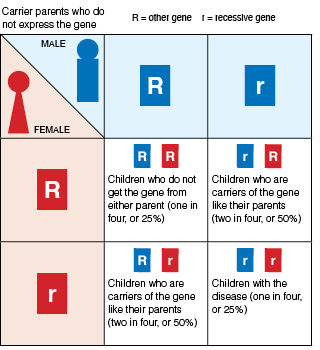When a disease or condition runs in families, it is called an inherited disease. You inherit a disease through your genes. Genes are the tiny blueprints your body uses for making proteins. Proteins are substances your body needs to develop and work the way it should.
Most genes come in pairs. You inherit one half of the pair from your mother and the other half from your father. A mutation is a change in a gene that makes it different from the copy you got from your parents. A mutation can cause a disease or condition. Or it can cause no problems at all.
Each gene tells your body to work in a certain way. Often genes work together. Sometimes a single gene pair tells your body what to do. Sometimes you need both genes in a pair to be exactly the same to have something happen. This is called autosomal recessive inheritance.
Autosomal recessive genes

Your genes are grouped together on structures called chromosomes. You have 23 pairs of chromosomes. One of these 23 pairs of chromosomes is called the sex chromosomes. This pair determines if you are female or male.
Autosomal inheritance of a gene means that the gene is located on 1 of the 22 other pairs of chromosomes. This means that boys and girls (or men and women) are equally likely to have the gene. Recessive means that you must inherit both copies of the changed gene in order for you to have the trait. If you have only one copy of the recessive gene, you won’t have the trait or the disease. Instead you will be a carrier for the trait or disease. But you won’t be able to tell that you are a carrier without a genetic test.
Most people don’t know they have a change to a recessive gene for a disease until they have a child with the disease. Or they may find out if they have a brother or a sister with an inherited disease and learn they are a carrier for that disease (one changed copy of the gene). Once the same parents have had a child with a recessive disease, they have a 1 in 4 chance of having another child with the same disease. This is true for every child born after that first child. Their other children have a 2 in 4 chance of being a carrier of the recessive gene.
The birth of a child with a recessive condition is often a total surprise to a family. This is because, in most cases, the parents had no family history of the condition. Your healthcare provider may ask you about more distant relatives who might have had similar conditions in the past.
Experts estimate that all people carry at least one recessive gene that could cause genetic diseases or conditions. But the only way you’ll know that you have the gene is if you have a child with a partner who has the same copy of the gene. Even then, your child may not have the disease (because of the 1-in-4 chance).
Mutations in certain genes have happened over time in different parts of the world. Certain ethnic groups are more likely to carry certain recessive gene mutations because of where the mutation started. For instance, people of African descent are more likely to have sickle cell disease. Cystic fibrosis is more common in white people in the U.S. It is less common in other ethnic groups.